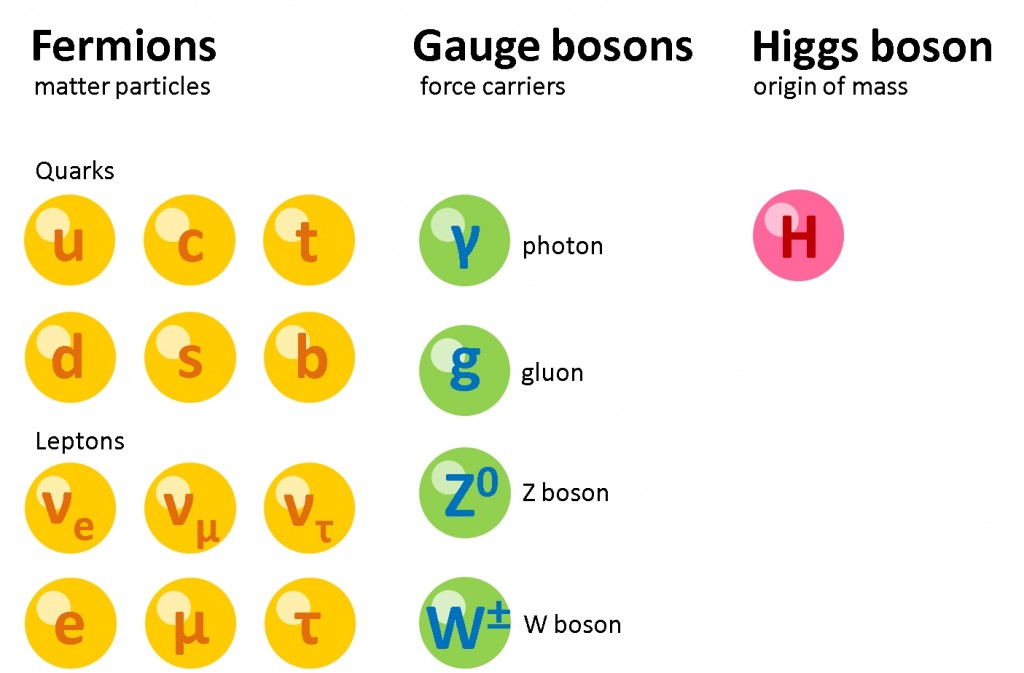At the end of Our Dynamic Universe, we considered big things like stars, galaxies and the Universe itself. Now the Particles and Waves unit brings us to particles so small we need groups of them just to make a single atom. Is there a connection?
Why do we study particles? from mr mackenzie on Vimeo.
The Standard Model
An elementary (or fundamental) particle is a particle that is not built from other, smaller particles. Until the start of the 20th century, scientists had believed that atoms were elementary particles. However, the discovery of the electron (J.J. Thompson), proton (Rutherford), and neutron (Chadwick), together with Rutherford’s evidence for a heavy, positively charged nucleus at the centre of the atom suggested the atom was not an elementary particle after all.
Brian Cox explains in this video clip…
To go further, we have to introduce some particle physics vocabulary.
These new elementary particles are part of our Standard Model of how the building blocks of the universe interact with one another. The particles that form “matter” are called fermions, after Enrico Fermi (Fermi has an incredibly long list of things named after him). The fermions are divided into two groups; quarks and leptons, as shown in the diagram below.
The Standard Model of Particle Physics. image: The University of Tokyo
Quarks
Quarks were predicted independently by theoretical physicists Murray Gell-Mann and George Zweig. The Nobel Prize in Physics was awarded to Gell-Mann in 1969 (interview here).
Quarks are held together in groups of two or three by the strong nuclear force, which acts via the exchange of gluons. Particles made from quarks are called hadrons. The subatomic particles we call protons and neutrons are actually made from quarks, so protons and neutrons are examples of hadrons. Protons are smashed together at CERN in a particle accelerator called the Large Hadron Collider.
What is the LHC? from mr mackenzie on Vimeo.
Quarks make up many different particles, so the hadrons are classified in two groups; those made from two quarks are called mesons, while particles made up from three quarks are called baryons.
- protons are made from two up quarks + one down quark
- neutrons contain two down quarks + one up quark
so protons and neutrons are baryons.
You may recall from Our Dynamic Universe that baryonic matter (matter made from baryons) i.e. protons & neutrons, only accounts for about 4% of the mass in the Universe.
Mesons have short lifetimes, even the most stable mesons exist for less than a millisecond. Mesons are a bit complicated because they contain one of the six quarks from the Standard Model bound to an antiquark by the strong nuclear force. An antiquark is the antiparticle of one of the six quarks. Antiquarks are an example of antimatter.
Antimatter was proposed in 1928 by British physicist Paul Dirac, who won the Nobel Prize in 1933 for his work. If a particle combines with its antiparticle, the two particles annihilate to produce pure energy. Consequently, a meson can’t be formed by a quark bound to its own antiquark.
Scientists are trying to discover out why our Universe is overwhelmingly matter-based. At CERN, the LHCb experiment is looking at quarks produced during proton-proton collisions to find out what happened to all the antimatter produced during at big bang.
The physicists at Sixty Symbols have a slightly different take on quarks
Leptons
The 6 leptons exist individually, rather than joining together to form new particles. The electron (e), muon (μ), and tau (τ) have mass and a negative charge, while the electron neutrino (Ve), muon neutrino (Vμ), and tau neutrino (Vτ) have no charge. The weak nuclear force acts on all leptons and the three charged leptons are also acted upon by the electromagnetic force.
While we’ve met the electron several times, this is only the second time muons have been mentioned. In Our Dynamic Universe, we learned how the presence of muons at ground level is explained by the special theory of relativity. The muon was discovered in 1936 by American Physicist Carl Anderson. 1936 was a great year for Anderson, it’s also the year he won the Nobel Prize in Physics for his discovery of the positron, the antiparticle of the electron. Just 4 years after Dirac’s prediction, Anderson discovered the trail of a “positively charged electron” in 1932 and proved the existence of antimatter.
It was thought neutrinos are massless in the Standard Model. However, the Nobel prize in Physics 2015 was awarded to both Takaaki Kajita and Arthur B. McDonald for their experimental discovery of neutrino oscillations, which demonstrates that neutrinos must have mass. It is incredibly difficult to detect neutrinos because these particles rarely interact with anything. Since neutrinos have a mass, albeit a very small mass, they may be the source of dark matter – the “missing” mass of the universe.

